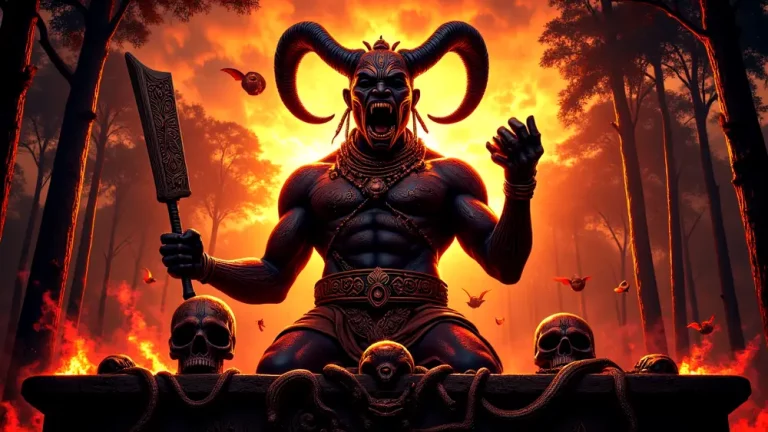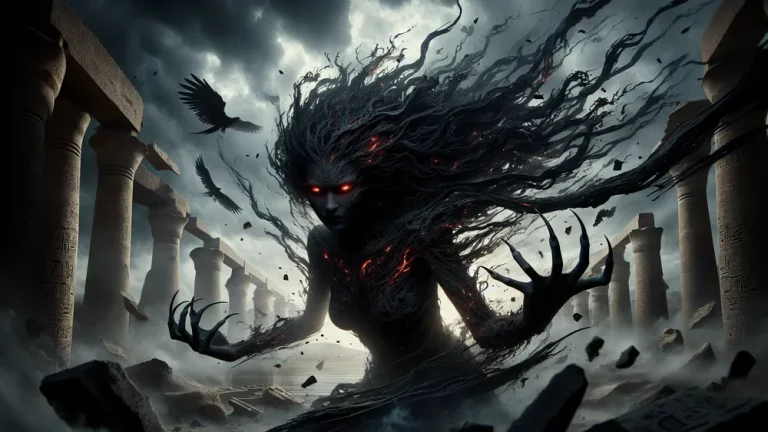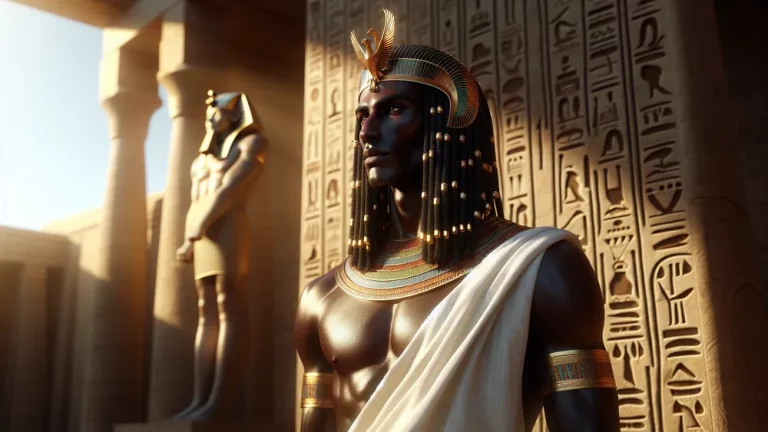Typhon: The Formidable Serpentine Giant Of Greek Mythology
As you look into the intriguing fabric of Greek myths, Typhon stands out as a fearsome, serpent-like giant who is quite a big part of these ancient Greek stories. Described often as the scariest creature of Greek legend, Typhon stands for chaos and overwhelming strength, showing humankind’s past feelings and amazement with nature’s wild forces.
Key Points:
- Typhon is a giant born from Gaia and Tartarus, symbolizing chaos and power.
- He has a hundred snake heads and dragon scales, representing a huge threat.
- Typhon fought Zeus, embodying nature’s chaos against divine order.
- After being defeated, Typhon was trapped under Mount Etna.
- He is the father of many creatures like Cerberus and the Hydra.
- Typhon’s story means the ongoing fight between chaos and civilization for Greeks.
- He influenced art and literature, showing Greeks’ need for balance and control.
There are stories, and they vary, that agree on Typhon’s importance as a sign of deep disorder, initially shaking up the new order of the Olympian gods. His roots are in divine family lines, making him a prime example of monster kids born from the earth lady Gaia and the underworld being Tartarus.
This introduction gives way for a deeper look into Typhon’s part as both a troublemaker and a key figure in the myth-based stories that lay out the never-ending battle between chaos and order in ancient Greece. As you keep reading this post, you will come across Typhon’s roots, his scary look, big battles, and his lasting mark on the cultural and myth-based scene of Greece long ago.
Typhon: Overview and Key Facts
| Key Aspect | Description |
|---|---|
| Origin | Typhon comes from Gaia, who is the Earth goddess, and Tartarus, a basic power representing the deep underworld. |
| Physical Appearance | He is a huge and scary creature, part man and part animal. With a hundred snake heads and skin with dragon scales. |
| Role in Mythology | Indicates chaos and wild parts of nature, often seen as a strong opponent fighting against the gods of Mount Olympus. |
| Major Mythological Event | Mainly about his big fight with Zeus, trying to beat him but was left defeated and put under Mount Etna. |
| Progeny | Typhon is the dad of many known mythical creatures like Cerberus, the Hydra, and the Chimera, who got frightening abilities. |
| Cultural Impact | Means the struggle between scary chaos and the need for order and civilization, touching Greek rituals and arts. |
| Variations in Myths | Different stories give varied views of his acts and his loss, spotlighting the many versions in Greek writings and art. |
Typhon in Greek Mythology
When you want to grasp how much Typhon affects things in Greek myths, you need to look at the stories about how he began, his scary look, and his big fights with the gods.
Where Typhon Comes From
Typhon’s start in Greek stories is rooted in the core of old power. He is born from Gaia, who is Earth, and Tartarus, the dark place under all. This powerful ancestry puts Typhon up alongside many ancient Greek beings who mean wild and strong forces. Gaia and Tartarus together stand for mixing life on Earth with scary depths. This made a being, a creature really, of great strength and destruction. Other mythical beings, like Typhon, are born from complex divine families, which affect their roles in tales we know. For instance:

- Echidna: Often seen as Typhon’s partner, she is also a creature that means chaos, sharing much the same traits as Typhon.
- Oceanus: A Titan from Gaia and Uranus, who stands for the world’s river, this shows how important primal forces are in Greek ideas of order.
- Hecate: From Titans, known for using magic and witchcraft, showing how heritage affects roles in myths.
For these reasons, the links between them show how divine family lines shape what mythological figures do and control, and they help us see why Typhon’s background makes him a disorder maker in Greek stories.
Typhon, born from Earth (Gaia) and the deep void (Tartarus), symbolizes a blend of life and chaos, which defines his role as a force of destruction in Greek tales.
How Scary Typhon Looks
Typhon is a huge mix of man and beast, rooted in ancient stories where his scary look stays memorable in Greek myths. His size, reaching the stars, suggests a titan-like force able to make the ground shake. He has many snake heads all over his body that can make loud sounds like roars, hissing, and even human cries.
People usually say his bottom part is all snakes, moving in unpredictable ways, much like a big snake connected to the chaotic beginning. His eyes glow with fierce fire, and his wings are wide enough to block sunlight, which means he is a strong force of ruin against the usually calm gods.
Interestingly, when comparing Typhon with other scary figures in Greek stories, you can see how he is different yet similar to the world of myth monsters. For example:
- Medusa: Like Typhon, Medusa has snake parts – her hair with poisonous snakes, but she is smaller and can turn people to stone with a look.
- Cyclops: These giants have one eye and share Typhon’s large size, but they are more about strong physical power, unlike Typhon’s snake-like complexity.
- Lernaean Hydra: Another snake-like being, also Typhon’s child, shows the ability to grow back parts, connecting them in endless energy and similar traits.
Looking at Typhon with these creatures, we see that his form isn’t just how he looks. It’s a strong sign of chaos and drama, which affected his actions with gods and built his place in myths.
Typhon and Zeus Go Head to Head
The huge fight between Typhon and Zeus is a key part of Greek myths because it is the main example of what happens when wild disorder meets organized control. After Zeus took over the universe, Typhon came up against him. He was the force of nature that gods had to manage. Showing boldness and using storms, Typhon attacked Zeus, roaring in a way that made the ground move.
His power came from his huge size and the many snake heads that could all cause trouble. But Zeus, with his Thunderbolts, stood up to Typhon’s raw strength with smart planning. The fight went all over the land. Typhon had a moment when he was winning by taking Zeus’s tendons, but with Hermes’s cleverness, they went back to Zeus.
This part showed how gods did not just rely on being strong but also on being smart.

Interestingly, every part of this great fight can mean something deep in Greek culture. Typhon was the wild parts of the world that needed divine control. Zeus was the order that gods set up. When, at last, Zeus used his thunderbolts more fiercely than ever, he beat Typhon, putting him under Mount Etna. Greeks said his fiery breath was why the volcano eruptions happened. Through winning, Zeus made sure he stayed the boss in the god world, holding back the old disorder Typhon wanted to free. This fight can be seen in the table below:
| Aspect | Typhon | Zeus |
|---|---|---|
| Initial Strength | Big size, making storms, many snake heads | Skilled with thunderbolts, strong leader |
| Temporary Triumph | Took Zeus’ tendons | Got help from Hermes to fix the situation |
| Final Strategy | Tried to win using raw wildness | Used thunderbolts wisely and with strategy |
| Outcome | Stuck under Mount Etna, his chaos contained | Made the universe orderly, keeping god rule |
Typhon’s Kids
Typhon and his partner Echidna, called the “Mother of Monsters,” continued their terror and chaos with a family of strong children, each with unique traits picked up from their scary parents. Cerberus is the famous guard of the Underworld, meaning Typhon’s scary size with his three big heads and snake-like looks. This dog’s job is to stop the living from going in and the dead from leaving; this job means keeping chaos but with duty.
The Chimera, an idea of mixing, has a lion’s head, a goat’s body, and a snake tail. It means the mix of different beings and could breathe fire, a skill that connects back to Typhon’s fiery ties.
The Lernaean Hydra was much like Typhon in how it could grow two heads for each one cut off, showing Typhon’s never-ending and growing chaos, a problem that Heracles struggled against in his tasks. By looking at these creatures’ roles in Greek myths, one can see a theme of badness and disorder from their father.
Cerberus’s role makes a link from the living world to the dead one, both keeping order and guarding access – a power despite the bad feel. The Chimera, in hero stories, was the opposite power that Bellerophon had to beat. And the Hydra, able to grow back, became almost like it couldn’t die, meaning chaos that doesn’t end, a big trait of Typhon’s power to destroy.
Together, these powerful children not only added to Typhon’s name in myths but also made important tests for heroes who learned through bravery and hard work in the stories of long ago.
How Typhon Shaped Ancient Greece
As Typhon’s story unfolds, you can see that both his scary children and the stories about him had lasting effects on how people in ancient Greece thought. As we go on to look at the cultural changes and impacts on society, we notice how Typhon’s legacy went beyond just myths to influence beliefs and practices.
Typhon’s Influence on People’s Lives
Typhon’s stories had a big effect on how people lived in ancient Greece, and this spread into both what they believed and what they did every day. In these stories, Typhon was the main example of chaos and natural disasters. Therefore, his stories were not only fun tales but also serious reminders about the huge forces of nature that could mess up human order.
People’s belief was that bad storms and volcanic eruptions came from Typhon’s anger, and these natural phenomena were linked to the powerful picture given by his story. This story of his helped people find some meaning and maybe some control in the face of big, unstoppable events from the natural world.
In those times, telling stories out loud was very important, and these stories showed basic truths about people and the world around them. Thus, they became a part of religious practices and the shared Greek identity. Typhon’s myth echoed through religious ceremonies and festivals meant to make the gods happy, showing the strong belief that chaos needed to be balanced with divine order.
In ancient Greece, Typhon’s stories were central to how people understood the natural world’s chaos and were woven into daily life and religious practices to balance it with divine order.
Typhon in Art and Books
Typhon, who was really powerful and scary, found a lasting spot in both Greek art and literature. This gave him a long-lasting impact in how ancient Greece expressed its culture. Artists and writers used his shape and stories to mean not just the power of chaos, but the fight between order and disorder, which was an essential thing in many ancient stories. Typhon’s many snake heads and giant size were often painted to show the scary nature that made him feared and also looked up to. In books, his story comes alive in several old works that give insight into how people in old Greece understood their world. A key source is Hesiod’s “Theogony,” where Typhon’s fight with Zeus is shown, showing that divine order wins over chaos. Another important mention is in Apollodorus’s “Bibliotheca,” which gives a detailed look at Typhon’s family and the huge challenge he gave to the gods. Here is a short list of important works where Typhon plays a big role:
- “Theogony” by Hesiod
- “Bibliotheca” by Apollodorus
- Different old vase paintings that mean Typhon’s fight with Zeus and monstrous form
- Homer’s hints about Typhon in long poems, pointing to his lasting impact
In these art forms and writings, Typhon stands as a big sign of chaos and the need to keep it under control, a basic idea that fits with how the old Greeks thought about needing balance and order.
A Look at Typhon and Other Huge Myth Monsters
When we look more closely at the detailed world of myths, Typhon’s huge size makes us think about how these really big creatures compare in different cultural stories. So, let’s move on to look at how this Greek giant matches up with other large mythological figures.
Typhon and Other Myth Giants
When you look at Typhon next to other myth giants, there are interesting things to learn about how different cultures thought of really big and powerful creatures. Among Norse stories, Jörmungandr, the huge sea snake that wraps around the world, is famous.
Typhon is thought of as a storm-giant filled with chaos and wild power, while Jörmungandr means the never-ending cycle of fate and time, showing that everything is connected in some way. Though both have serpentine features, making them appear both strange and mighty, their roles in their stories are quite different.
Like how Typhon’s fight with Zeus means the big struggle of chaos against order, and Jörmungandr’s part in Ragnarök, the end-of-the-world story, includes everything being destroyed and starting over again.
Here’s a simple list that shows these points:

- Similarities:
- Differences:
Looking at these stories shows that, though cultures can be very different, their myths often talk about big ideas of greatness, disaster, and the balance of the universe.
How Typhon Fits in Other Greek Stories
After looking at Typhon’s part with big myth giants, we need to think about how he impacts other Greek stories and continues to change the world of myths. Now, let’s look at how he spreads through these old tales.
Myths That Show Typhon’s Impact
Typhon’s big impact is seen in many Greek myths, shaping stories and changing what the Olympian gods do in big ways. The most famous story is his big fight with Zeus, which is told in Hesiod’s “Theogony.” This means a major change from early chaos to divine order, setting up the Olympian dominion in the universe.
Typhon made the gods run away, showing his huge strength, until Zeus brought them together, which means ideas about staying strong and leading well that are central to Zeus being shown as the king of gods. Moreover, Typhon is linked with creating dangerous winds and storms, often seen as the hidden force behind natural disasters in other stories.
This connects him not just to disorder and chaos, but also means the Olympian gods have a part in keeping things balanced. In stories like those about Poseidon, where the ocean’s anger might be due to Typhon’s power, these tales teach about nature’s power and how the gods play a role in controlling it.
They are key lessons on how everything is connected and fragile within the world made by Greek myths.

Typhon’s Role in Myth Shifting Eras
Typhon is an important character in Greek mythology, being part of the change from very early chaos to more settled order under the Olympian gods. Born from Gaia and Tartarus, his beginnings mean a link to earth and wild forces of the early universe, a time when earth and deep down mattered more than people find easy to get today.
His life means a time of natural wildness, like stormy seas or wild places that people have tried to learn about and control.
The victory of Zeus and the other gods over Typhon is a big change, and it means not only that Zeus keeps his top place but also points to a bigger story about moving from unsure nature to a world of rules and order.
People have gone from living with nature always challenging them to building systems that let life be steady and foreseeable, a bit like making shelters to deal with weather. Stopping the chaos by beating Typhon is more than just a fight story; it is about how people want to make things calm and in order.
The World of Greek Myth Creatures and Monsters
The Greek myths have many special creatures and strong monsters, and they make us think with their unique traits and exciting stories. These famous beings, from big animals to scary mixes, are important in stories that mean not just fights between gods and titans but also show bigger ideas of being brave, fear, and what is unknown. In these tales, you can see more in a list of all Greek Creatures and Monsters.
This gives you more detail about the interesting things that are in old stories and still catch people’s attention today.
FAQs
1. What eventually happened to Typhon after his battle with Zeus?
What eventually happened to Typhon after his battle with Zeus is that he was ultimately defeated and imprisoned beneath Mount Etna.
2. How is Typhon depicted in modern interpretations of Greek mythology?
In modern interpretations of Greek mythology, Typhon is often depicted as a colossal and terrifying giant with a serpentine form, embodying primordial chaos and destruction.
3. What was Typhon’s most feared power?
Typhon’s most feared power was his ability to unleash catastrophic storms and emit a cacophony of terrifying sounds that could instill panic among gods and mortals alike.
4. How did Typhon’s defeat influence Greek mythology?
Typhon’s defeat by Zeus reinforced the Olympians’ dominance and established a mythological narrative of order triumphing over chaos.







